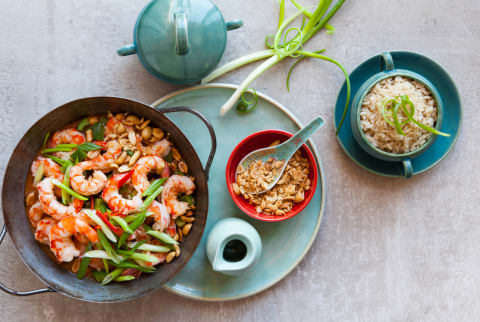Advertisement
If You're Not Eating This Food, You'll Never Be Able To Heal Your Gut


If you think all carbohydrates are bad, resistant starch might change your mind. This healthy carbohydrate boasts a ton of gut-healthy benefits. It's also incredibly easy to incorporate into your everyday diet.
What is resistant starch?
Resistant starch is a type of prebiotic, insoluble dietary fiber that resists normal digestion in the small intestine. It makes its way to the large intestine undigested, where it preferentially feeds the good bacteria. The bacterial fermentation of resistant starch produces butyrate1 and other beneficial short-chain fatty acids (SCFA) that are an important fuel source for colonic cells. These SCFAs help maintain a normal colonocyte population, which contributes to healthy function and disease prevention in the large intestine.
What are the types of resistant starch?
There are four main types of resistant starch2, which are classified based on their source.
Type I refers to starch that is physically inaccessible to digestive enzymes because it’s trapped in plant cell walls. This is found in grains, seeds, and some legumes.
Type II is untreated starch from high-amylose plants known to resist digestion in their raw state. Cooking these foods removes the resistant starch. This includes raw potatoes, green bananas, and raw plantains.
Type III is "retrograde starch," which refers to starchy foods that have been cooked then cooled, which changes the structure and renders them more resistant to digestion. This includes cooked then cooled potatoes, rice, and other grains.
Type IV refers to starch that has been chemically modified to resist digestion and does not occur in nature. This is typically found in processed foods and is included here for completeness but not recommended.
What are the health benefits of resistant starch?
Preparing carbohydrates in a way that increases the resistant starch content can actually blunt the blood sugar response and help you lose weight. It’s been shown to help prevent and control obesity, diabetes, cardiovascular disease, and even cancer.3 What's more, resistant starch feeds a healthy gut microbiome and can help get your gut flora back in balance. As a functional medicine doctor, I know that interventions to improve gut health tend to improve overall health.
1. Resistant starch can help with leaky gut and overall gut health.
Consumption of resistant starch can improve intestinal permeability (aka leaky gut), which is a root cause of inflammatory conditions, autoimmune diseases, and food sensitivities. It has been shown to improve mucosal barrier function4 and reduce endotoxin influx5 from the intestinal tract. Long-term intake of resistant starch can also reduce colonic and systemic immune reactivity4.
2. Resistant starch can help with weight loss.
Resistant starch can even help with weight loss. A healthy gut microbiome can improve obesity6 and help maintain a healthy weight in itself. But consumption of resistant starch has specifically been shown to enhance satiety and fullness, which reduces the drive to eat. When combined with regular exercise, it’s been shown to preserve lean muscle mass and reduce fat storage. Resistant starch also demonstrates a positive effect on the bioavailability and intestinal absorption of calcium, iron, zinc, and other minerals7. This is likely one reason that it can minimize the loss of bone mass during weight loss.
3. Resistant starch can balance blood sugar.
Despite the concern for carbohydrates spiking blood sugar, numerous studies on resistant starch show the opposite effect. The decrease in obesity associated with consumption of resistant starch is significant enough to improve insulin sensitivity8. It has been shown to decrease insulin spikes after meals9 in healthy subjects and also improve insulin sensitivity in people with metabolic syndrome10. When combined with soluble fiber, resistant starch has demonstrated improved glucose metabolism11 in both normal and overweight women. Interestingly, resistant starch even contributes to a "second-meal effect12" whereby it has the potential to regulate blood sugar and insulin responses in a subsequent meal. It is associated with reduced risk of developing type 2 diabetes and cardiovascular disease. This study13 showed consumption of resistant starch had a favorable effect on cholesterol and blood sugar levels in overweight individuals.
4. Resistant starch can help prevent cancer.
Research also links resistant starch consumption to the prevention of colorectal cancer14. Likely one reason for this is the generation of butyrate, which has been studied for its ability to kill colorectal cancer cells and mediate tumor growth15. The butyrate produced by resistant starch may also confer protection16 against potentially detrimental effects of dietary red meat. And although the hypothesis behind butyrate is the most well-studied, the role of gut bacteria and cancer risk17 is generating a lot of attention lately. Specifically, the bacterial species Fusobacterium nucleatum may play a causal role in colorectal cancers. Perhaps the most significant attribute of resistant starch is its positive effects on the gut microbiome.
What are the best food sources of resistant starch?
The good news: It's super easy. You can create resistant starch either by purchasing foods that are high in it or by preparing food in a way that increases the resistant starch. The best bet is variety and whole food sources, as different types of resistant starch favor different types of gut bacteria, and we know that microbial diversity in the gut is important.
1. Green Bananas
Buy green (unripe) bananas, then peel and freeze them for use in smoothies.
2. Dried Plantain Chips
Slice and dehydrate slightly green plantains, and enjoy as a crunchy snack with guacamole or salsa. Note that these will have a higher resistant starch content if you dehydrate them, but you could also bake at very low heat (less than 130°F).
3. Cooked and Cooled Sweet Potatoes
Roast a big pan of chopped sweet potatoes with your favorite seasonings, and cool them in the refrigerator to raise resistant starch levels. These make great leftovers and are also good tossed into a big green salad. If you don’t want to eat them cold, this type of resistant starch will withstand gentle reheating as long as you keep the heat low.
4. Potato Salad
Prepare your favorite recipe using red potatoes that have been cooked then cooled. I’m a fan of French-style potato salads that use an olive oil vinaigrette and fresh herbs.
5. Fried Rice
Soak, rinse, and prepare organic basmati or jasmine rice as you normally would. Then cool it in the refrigerator and use it to make a quick fried rice with vegetables, eggs, sesame oil, and gluten-free tamari or coconut aminos. Be careful not to reheat the rice too high or too long.
6. Quinoa Tabbouleh
Soak, rinse, and prepare quinoa as you normally would. Then cool in the refrigerator and make a cold tabbouleh salad full of parsley, cucumbers, tomato, lemon, and olive oil.
7. Hummus
If you tolerate legumes, use soaked chickpeas to make hummus. Hummus made from soaked chickpeas versus canned chickpeas will contain higher levels of resistant starch. Serve with olives and fresh vegetables or alongside the tabbouleh.
8. Tigernuts
These aren’t actually nuts at all but rather little tubers with high amounts of fiber and resistant starch. They can be eaten on their own straight out of the bag, but the texture is a little dry. I recommend using them in trail mix or chopping them up for use atop salads.
9. Raw Potato Starch
This is probably the easiest way to add resistant starch to your diet, although I think focusing on whole food sources of resistant starch is always a better idea. Bob’s Red Mill Unmodified Potato Starch (not flour) can be added to smoothies or even stirred into sparkling water. Start with a tablespoon and slowly increase as tolerated. If you are strictly avoiding nightshades, another option would be plantain flour or green banana flour. To maintain the resistant starch content, flours should not be heated above 130°F.
Are there any side effects of resistant starch?
When incorporating resistant starches into your diet, start with small doses and gradually increase as tolerated. Gas and bloating may occur as your gut flora changes and adapts. If you experience significant gastrointestinal symptoms with even small amounts of resistant starch, this may be a sign of small intestine bacterial overgrowth (SIBO), yeast overgrowth, or dysbiosis (an imbalance of gut bacteria). In this case, I recommend working with a functional medicine doctor to address these issues.
Looking for more gut guidance? A functional doctor and gut specialist shares his best (and worst!) food picks for gut health.
17 Sources
- https://www.ncbi.nlm.nih.gov/pubmed/21430242
- https://academic.oup.com/advances/article/4/6/587/4595564
- https://www.ncbi.nlm.nih.gov/pubmed/24228189
- https://www.ncbi.nlm.nih.gov/pubmed/17936196
- https://www.ncbi.nlm.nih.gov/pubmed/14748878
- https://www.ncbi.nlm.nih.gov/pubmed/19901833
- https://www.ncbi.nlm.nih.gov/pubmed/8726244
- https://www.ncbi.nlm.nih.gov/pmc/articles/PMC4220782/
- https://academic.oup.com/ajcn/article/82/3/559/4862973
- https://www.ncbi.nlm.nih.gov/pubmed/20536509
- https://www.ncbi.nlm.nih.gov/pubmed/16644623
- https://academic.oup.com/ajcn/article/83/4/817/4649162
- https://www.ncbi.nlm.nih.gov/pubmed/15242012
- https://www.ncbi.nlm.nih.gov/pubmed/23385525
- https://www.ncbi.nlm.nih.gov/pubmed/22676885
- https://www.ncbi.nlm.nih.gov/pmc/articles/PMC4531472/
- https://www.sciencedirect.com/science/article/pii/S1044579X17301463
Watch Next
Enjoy some of our favorite clips from classes
Enjoy some of our favorite clips from classes
What Is Meditation?
Mindfulness/Spirituality | Light Watkins
Box Breathing
Mindfulness/Spirituality | Gwen Dittmar
What Breathwork Can Address
Mindfulness/Spirituality | Gwen Dittmar
The 8 Limbs of Yoga - What is Asana?
Yoga | Caley Alyssa
Two Standing Postures to Open Up Tight Hips
Yoga | Caley Alyssa
How Plants Can Optimize Athletic Performance
Nutrition | Rich Roll
What to Eat Before a Workout
Nutrition | Rich Roll
How Ayurveda Helps Us Navigate Modern Life
Nutrition | Sahara Rose
Messages About Love & Relationships
Love & Relationships | Esther Perel
Love Languages
Love & Relationships | Esther Perel
What Is Meditation?
Box Breathing
What Breathwork Can Address
The 8 Limbs of Yoga - What is Asana?
Two Standing Postures to Open Up Tight Hips
How Plants Can Optimize Athletic Performance
What to Eat Before a Workout
How Ayurveda Helps Us Navigate Modern Life
Messages About Love & Relationships
Love Languages
Advertisement

These Peanut Butter Cup Protein Bites Make The Perfect On-The-Go Snack
Molly Knudsen, M.S., RDN










